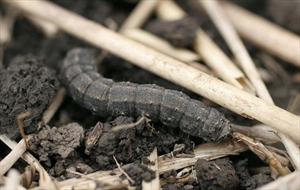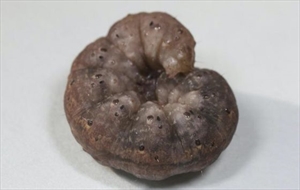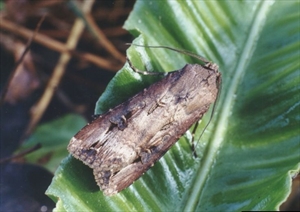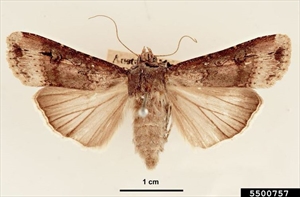Black cutworm, greasy cutworm
Pacific Pests, Pathogens and Weeds - Online edition
Pacific Pests, Pathogens & Weeds
Black cutworm (297)
Agrotis ipsilon. It is a member of the Noctuidae.
Asia, Africa, North, South and Central America, the Caribbean, Europe, Oceania. It is recorded from Australia, Cook Islands, Fiji, New Caledonia, New Zealand, Papua New Guinea, Samoa, Tonga.
Wide; beans, brassicas, carrot, celery, cucurbits, lettuce, onion, peanuts, maize, radish, sugar beet, sunflower, tobacco, tomato and many more crops, and also weeds.
The caterpillars (larvae) do the damage. Young larvae feed on the plant and make holes in the leaves, older ones hide in the soil or in plant remains, and feed at night. They cut through stems just above soil level if the soil is moist; if the soil is dry the larvae chew into the plants below ground, and often the plants wilt and die. Plants may be dragged into tunnels made in the soil, and eaten during the day.
Eggs are white, dome-shaped, 0.5 mm diameter, laid in groups of 30 or more on the host plants, grasses, other weeds and debris; the larvae go through 5-6 moults and when mature are grey, greyish brown or black, up to 45 mm long. They have a narrow light strip along the back, and shiny black spots scattered over the body (Photos 1&2). The larvae curl up when disturbed (Photo 2). Pupation occurs in the soil. Moths are brownish, wingspans of 40-55 mm, with kidney-shaped spots and dagger-like markings on the forewings (Photos 3&4).
Spread of the moth occurs on the wind; it is a strong flyer, with migrations noted in several parts of the world (Asia, Indonesia, the Middle East and North America) where populations have suddenly appeared and disappeared.
Although the cutworm has the potential for considerable damage, outbreaks are relatively rare. The crops most severely attacked are maize, vegetables, cotton, tobacco, and turf grasses. An outbreak in Pennsylvania in 1980, for instance, decimated 2000 ha of maize. In general, loss of plants in infested fields varies from 20-80%, usually in patches. Larvae have considerable impact because they cut plants, and then quickly move to others to continue the cutting, so small populations do much damage.
Look for seedlings and young plants with holes in the leaves, chewed off at soil level, or have wilted. Look for the larvae in the soil at the base of the plant; when found the larvae will curl up. Inspect fields weekly, particularly maize (at the 1-4 leaf stage) and vegetables, assess the number of plants damaged, and look for the cutworms. If 5% of the plants are damaged (have holes and cut plants), and cutworms are present (1 every 3rd-4th plants), consider applying an insecticide.
NATURAL ENEMIES
Natural enemies are not well known, although a number of wasps are recorded attacking cutworms, and there are predatory beetles.
CULTURAL CONTROL
Before planting:
- If possible, avoid planting into fields with a history of cutworms.
- If possible, avoid planting the crops listed as hosts in land that has been in pasture for a long time.
- Weed before planting, within the crop area and at the borders. The problem with this recommendation is that without weeds, moths are forced to lay their eggs on crops; in some situations, weeds are the preferred hosts.
- Make sure that fields are well drained; cutworms are often worse in wet areas of fields.
During growth:
- Check for cutworms in the soil at the base of plants; if cutworms are found in home gardens, handpick and kill them; monitor large fields (especially maize) at the 1-4 leaf stage (see under Detection & Inspection).
- In home gardens, wrap aluminium foil around the base of stems. Netting or row covers are more effective.
- Use a homemade trap, placed 1.5 m above ground to catch moths: in a bottle with large openings at the sides place a mix of sugar, water, vinegar in a ratio of 6:10:3 (i.e., 1 teaspoon sugar, and 0.5 teaspoon vinegar in every 10 ml water).
- Grow flowering plants in gardens or at the side of fields to attract parasitoids.
After harvest:
- Collect and destroy plant remains by burning or burying them.
CHEMICAL CONTROL
Neem is effective against the young larvae. Many synthetic insecticides are registered (in Australia): commonly used is the pyrethroid, bifenthrin, and the organophosphates, chlorpyriphos and diazinon. These chemicals will also kill natural enemies. Bt, Bacillus thuringiensis is not recommended for cutworm control.
____________________
When using a pesticide, always wear protective clothing and follow the instructions on the product label, such as dosage, timing of application, and pre-harvest interval. Recommendations will vary with the crop and system of cultivation. Expert advice on the most appropriate pesticides to use should always be sought from local agricultural authorities.
AUTHOR Grahame Jackson
Information from CABI (2020) Agrotis ipsilon (black cutworm). Crop Protection Compendium. (ttps://www.cabi.org/cpc/datasheet/3801); and from Capinera JL (2018) Agrostic ipsilon (Hufnagel). Featured Creatures: Black cutworm. UF/IFAS, University of Florida. (http://entnemdept.ufl.edu/creatures/veg/black_cutworm.htm). Photo 1 Roger Schmidt, University of Wisconsin-Madison, Bugwood.org. Photo 2 Adam Sisson, Iowa State University, Bugwood.org. Photo 3 Ian Kimber, Bugwood.org; Photo 4 Pest and Diseases Image Library, Bugwood.org.
Produced with support from the Australian Centre for International Agricultural Research under project PC/2010/090: Strengthening integrated crop management research in the Pacific Islands in support of sustainable intensification of high-value crop production, implemented by the University of Queensland and the Secretariat of the Pacific Community.







